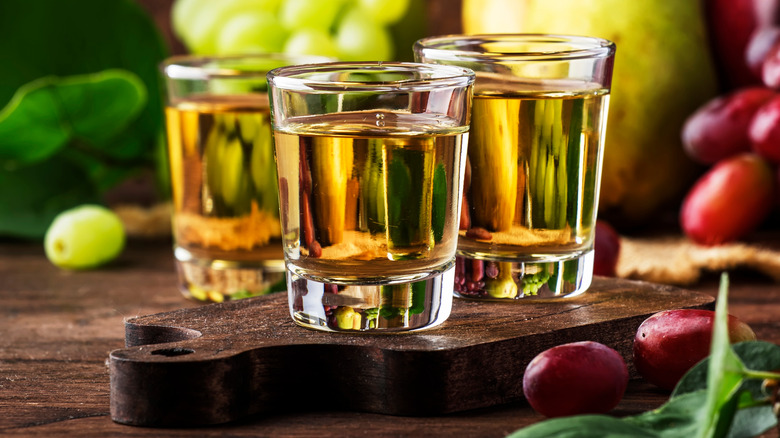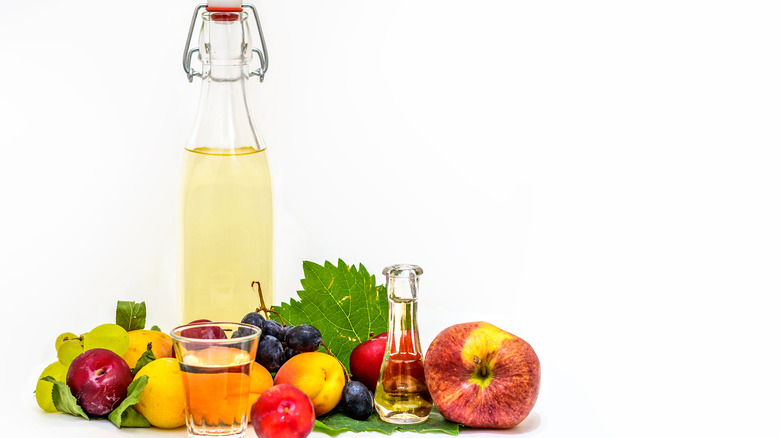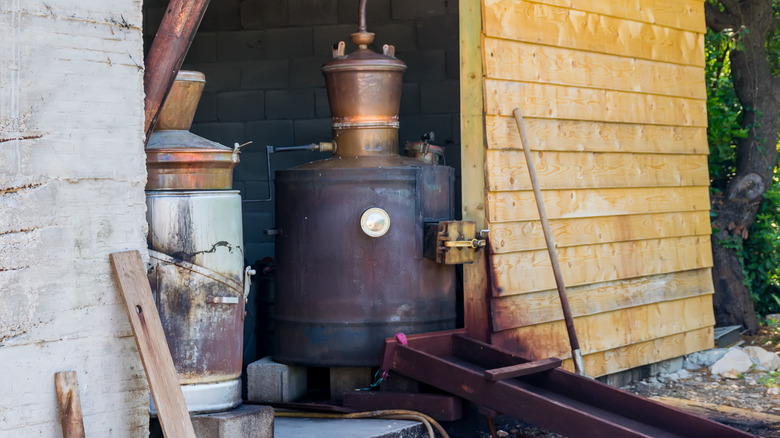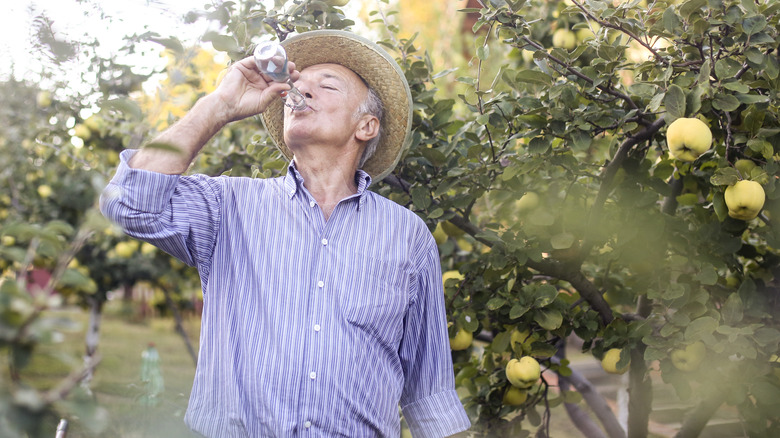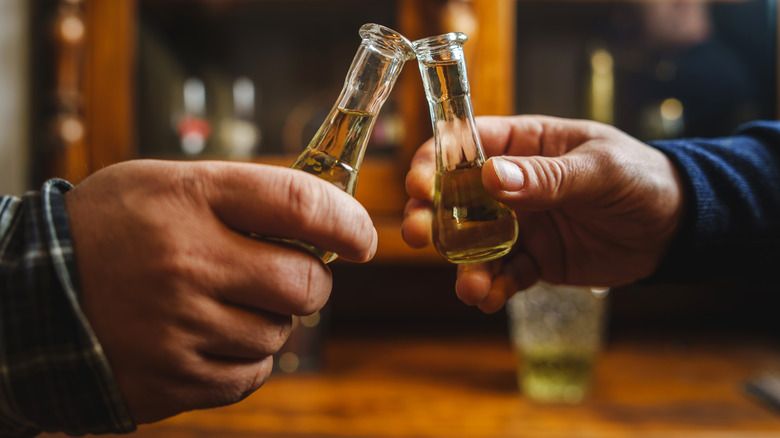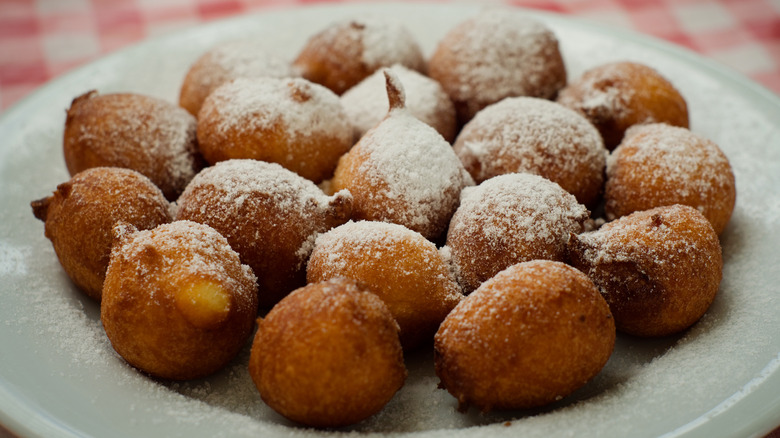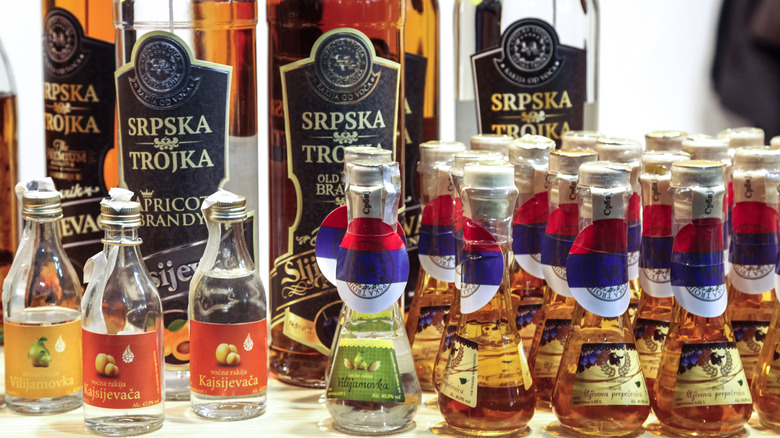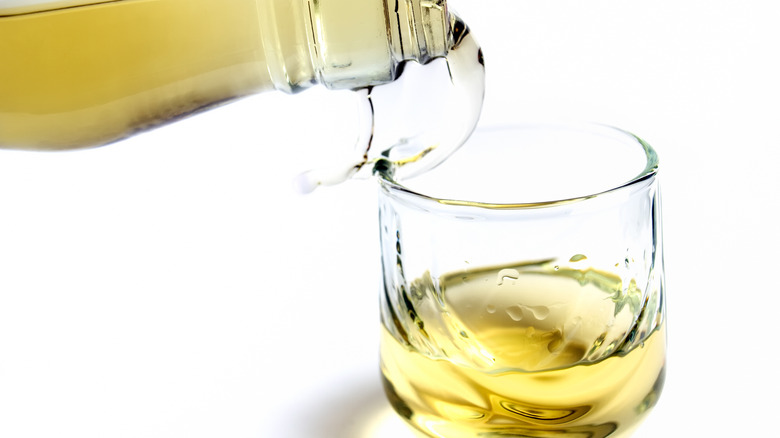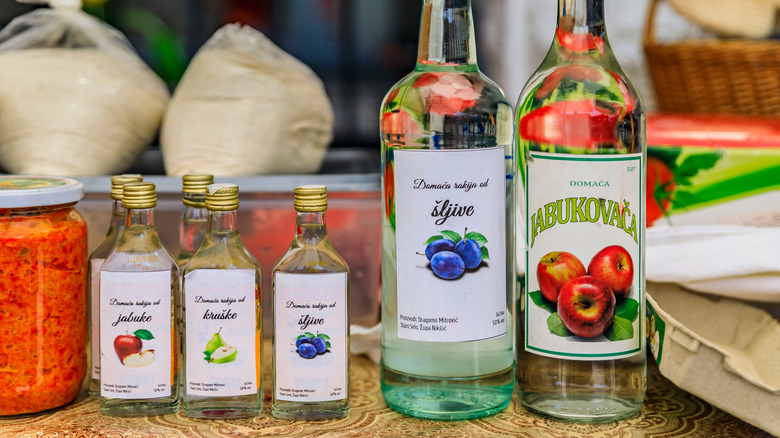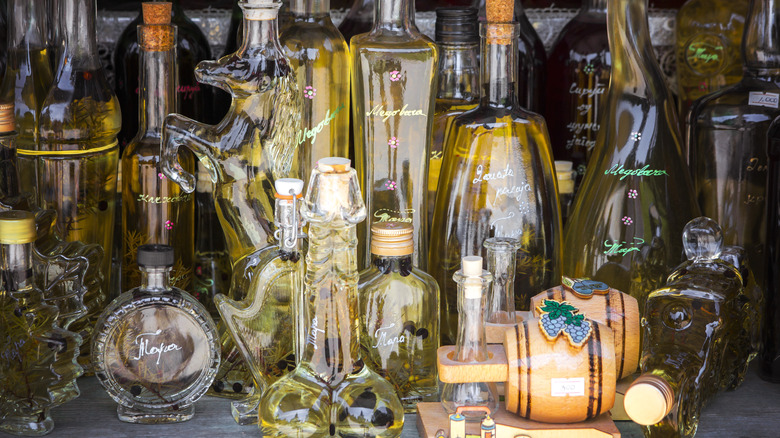What Is Rakia And How Do You Drink It?
Rakia is a true pan-Slavic spirit. It is considered to be the national drink of Serbia (where the word is spelled "rakija") and also of Bulgaria (where the "j" seems to come and go, and is sometimes replaced by a "y") and numerous other countries throughout eastern and central Europe also claim this beverage as their own. In fact, the question of exactly where the drink originated is a hotly debated one, as Serbia, Croatia, and Romania all feel entitled to this honor. Bulgaria does, as well, and it actually has an artifact to back this up: a 14th-century chalice inscribed "I have celebrated with rakija" (or the medieval Bulgarian words for same).
Boutique rakia is big business these days. Serbian and Bulgarian products are available in the U.S., while commercial rakia makers span the globe from Australia to Texas. Rakia's also a player in the celebrity booze stakes as Bill Gould of Faith No More is a partner in Serbia's Yebiga distillery. Just a few decades ago, though, rakia was the European version of Appalachian moonshine and it wasn't until 1985 that Serbia opened the first legal distillery. At that point, the floodgates opened, and as of 2022, the number of distilleries in that country alone was north of 800 and climbing. This is still analogous to moonshine, though, as the U.S. legalized commercial production of this spirit in 2005 and now Ole Smoky and other moonshine brands are almost as ubiquitous here as rakia is in Eastern Europe.
What is rakia?
Before we get into explaining what rakia is, let's clear up a little bit of confusion about what it isn't. Although the name is very similar to that of the Turkish spirit raki, the two are quite different. Raki is made from raisins and grapes and is known for a strong licorice flavor that comes from the anise seeds also included in the mix. Like the similar Greek ouzo and French pastis, it, too, takes on a cloudy consistency when mixed with water. Rakia, on the other hand, is a type of brandy distilled out of fruit and is unlikely to cloud up when you dilute it.
Rakia can be made from grapes, but plum rakia tends to be the most well-known kind throughout the Balkans. Slivovitz, as it's called, is also familiar outside the region and has been imported to the U.S. for over 50 years. Other fruits used to make rakia include apples, apricots, blueberries, cherries, figs, peaches, pears, quinces, and raspberries; while honey, lavender, and mint rakias also exist.
How is rakia made?
The first step in making rakia is to collect a rather large amount of fruit that is very ripe but not yet rotten or moldy. It may take about 100 liters of most produce to make just 5 liters of rakia, although Slivovitz only requires about 50 liters of plums to yield a similar amount. Still, that's a fair amount of fruit. Once you've acquired the necessary ingredient — and typically rakia is made with just a single type of fruit — you leave it to ferment all on its own. No yeast is added, but instead is spread by fruit flies, unappealing as this idea may be.
Once the fruit is sufficiently fermented, which may take up to six weeks, a top crust (called "krovina" in Croatia) is removed, and then the remaining fruit mush is cooked in a still. What the still does is to draw out the alcohol from the fermented fruit in the form of a vapor which is then cooled to convert it to liquid form. The ABV of the rakia is then measured with an instrument called an alcoholmeter and the liquid is diluted and re-distilled as necessary in order to reach the desired ABV (generally 40% or 80 proof).
What does rakia taste like?
As rakia can be made from a wide variety of different ingredients, it's hard to really characterize the taste. Some have compared the flavor to sake, despite the fact that it's much stronger (sake is typically just 13% to 17% ABV) and is also not made from rice. Others feel that rakia tastes similar to grappa, an Italian-made grape-based brandy with a similar ABV (usually 40% to 45%).
If you do a shot of rakia, what you'll taste at first is the booze, since any full-strength spirit will hit like that. Depending on what the rakia is made from, there may be some follow-up notes from the fruit, although generally the fruit taste will not be as pronounced as it would be in a fruit-flavored liqueur. Here the fruit, like the grains in whiskey or the rice in sake, serves mainly as raw material for fermentation. In some cases, such as with rakia made from grapes, there's not enough left of the fruit's essence to provide much in the way of flavor. Other fruits, however, at least leave a hint. Rakia made from apricots, pears, or quinces is said to have a particularly distinctive aroma, even if the flavor itself really isn't all that fruity.
How to drink rakia
How you drink rakia is pretty much the way you consume any liquid — pour it into a glass, bring it up to your mouth, open up, and swallow. In small amounts, of course, as it's strong liquor, not soda pop. While there are those who just shotgun down the stuff, doing so is generally frowned upon by those in the know (which is just about everyone in the Balkans, or at least the adults). Rakia is seen as being more of a sipping drink, so shots are bad form even if it comes straight up in small glasses. Rakia can serve as an aperitif or accompany appetizers, although it typically isn't served alongside the main course. While it can be chilled, room temperature is more common. Anecdotally, some people (usually the anecdote-teller's sweet old granny) are even said to enjoy rakia for breakfast.
Rakia cocktails are a thing, as well. There aren't too many traditional ones unless you count the Serbian Christmas punch known as vruca rakija, which is essentially a hot toddy made from sweetened diluted slivovitz. Vishnovka is a Bulgarian concoction of cherries steeped with rakia and sugar, but again, not really a cocktail. Bartenders in the U.S., however, have been experimenting with using rakia in place of whiskey or gin in drinks like the Old Fashioned and Tom Collins, while some have been crafting rakia-based cocktails with trendy ingredients such as chartreuse, vinegar, basil, or fancy salt.
Other uses for rakia
While rakia is, first and foremost, meant for drinking, from time to time people do put it to other uses. While its value as a "medicine" is just as dubious as any such claims made for other spirits (some of the latest research published in the Journal of the American Medical Association suggests that the healthiest type and amount of alcohol to drink is none at all), it can and has been applied externally as an antiseptic. Vodka, too, has similar germ-killing properties, but according to best medical practice, neither spirit (nor rubbing alcohol, for that matter) should be used for wound care as they can do more harm than good to damaged tissue.
A safer use for rakia may be as a household cleaning fluid or laundry stain remover. It's even purported to help keep cut flowers fresher for longer when a small splash is added to the water in their vase. Rakia can also be used in baking and cooking. Croatian fritters called fritule are made with rose or cherry rakia, while krostule cookies can include any type of rakia. Rakia is sometimes used to flavor cakes or trifles as well and has occasionally been known to put in an appearance in savory dishes such as meat marinades.
Where to buy rakia
As every travel blogger will tell you, the only "authentic" place to buy rakia is from a roadside vendor in some tiny little hamlet that no one's ever heard of but them. Sure, there are those who do sell their homemade hooch and others who give it away to guests in their homes, but commercial rakia is also widely available in Balkan bars and restaurants. Assuming that you are not in the Balkans, though, nor able to drop everything and fly over there for the sole purpose of rakia sampling, we'll shift our focus to where rakia can be purchased in the U.S.
If you live in or near a city with a large(ish) Balkan population such as Chicago, Milwaukee, Pittsburgh, or St. Louis, then you may be able to purchase a variety of different rakias at ethnic groceries or liquor stores. Online retailers such as Total Wine also carry a selection of rakias including both imports and domestic products like Texas-made Kinsman. Rakia is also available at certain bars such as Miami's Rakija Lounge and Balkan restaurants like Ambar with its three locations in the DC metro area.
Nutritional information about rakia
Rakia has a similar nutritional profile to other spirits such as vodka, whiskey, and, of course, brandy as it is a sub-type of this last-named liquor. Badel Alter Sljivovica, a type of plum brandy that comes in exactly at 40% ABV, has approximately 65 calories per ounce, which is the same amount found in just about any other hard liquor of equal strength. Rakia, like similar spirits, has no protein, carbohydrates, or other nutrients, so the calories it provides are considered empty.
Despite the fact that some claim rakia is a drink that can help with losing weight, it's nothing of the sort as a standard soda contains just 12.5 calories per ounce. Still, that's not really an apples-to-apples (or plums-to-plums) comparison, since if you knock back 12 ounces of rakia or any other alcoholic beverage, weight gain won't be the only problem you're facing. Heavy drinking, in the Balkans as elsewhere, is responsible for numerous health and social problems. What's more, there can be dangers inherent in home brewing, as well. One recent study published in the journal Helyon found that 90% of Albanian rakia sampled contained excessively high levels of one or more toxic heavy metals.
Varieties of rakia
While plum-based rakia, aka slivovitz, may be the most popular variety, grape-based rakias are holding steady in second place. Such grape-based beverages are an Albanian specialty, particularly the rakia known as Skrapari due to its being produced in the Skrapar region. Bulgaria is home to a rose petal rakia called gyulovitsa, while mastika is a North Macedonian variety flavored with anise. (This is the one rakia that probably will take on a cloudy appearance if you add water.) Perhaps the most intriguing of all rakia varieties is a Croatian kind called biska. This drink is steeped with mistletoe, although as far as we know it has no particular association with Christmastime kissing.
Rakia also has an offshoot spirit known as liker (liqueur). Liker is made with a base of rakia, often grape-based since it has the least favor of its own. Additional flavorings and sugar are then added to the rakia to make flavors such as borovniček (wild blueberry), kruškovac (pear), maraschino (sour cherry), and orahovak (walnut). Liker tends to be sweeter and more flavorful than rakia, although it is also only about half as strong. This beverage typically only contains 18% to 20% alcohol. Even though some disparage liker for being a weaker drink, it fits in quite well with the modern preference for lower-ABV drinks for hassle-free holiday festivities.
How to store rakia
While there's always some would-be wit who expresses incredulity that one could open a bottle of rakia (or any other kind of alcohol) and not finish it, the question of how to store the product is a legitimate one. The good news seems to be that even the home-brewed kind that is sold in repurposed plastic water or soda bottles is unlikely ever to go bad, although some suggest it will taste better if transferred to a glass bottle and sealed with a cork. Others seem to feel that, once a bottle's been breached, rakia will taste best if consumed within a five-day period. An unopened bottle of rakia, however, may well age into an even more flavorful drink, and, in fact, some higher-end rakias are barrel-aged for up to 20 years.
If you have no oak barrels on hand, a wine rack will do nicely for storing your rakia bottles, although it should be horizontal with perhaps a slight downward tilt so the cork stays moist to ensure a tight fit in the bottle. The rakia should be stored in a dark, cool place such as a basement, with the optimum temperature being between 55 and 68 F. If you're a true connoisseur, you may even want to monitor the recommended humidity (60% to 68% is recommended) or else invest in a wine refrigerator to better preserve your beloved Balkan beverages.
